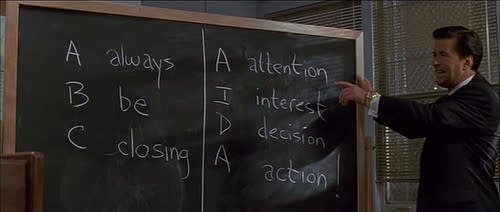 Business 2 Community
Business 2 CommunityBeginner’s Guide to Blogging: The Baldwin Approach to Headlines
Blogging isn’t going out of style any time soon; with the ascent of content marketing, blogging, podcasting and video are on the minds of marketers and PR professionals all the time. In this 10-part Beginner’s Guide to Blogging series, we’re going to explore what makes a blog great and give you some structures and frameworks to help make blogging easier. Take from it what works and leave behind what doesn’t work!
The Baldwin Approach to Headlines
In the movie Glengarry Glen Ross, Alec Baldwin’s character Blake famously reviews basic selling with a framework first created in 1898 by E. St. Elmo Lewis, and later codified by Frank Dukesmith in 1904.
The framework acronym AIDA stands for the below; producer David Mamet incorrectly substituted Decision for Desire in the movie:
Attention: Catch the audience’s attention by any means.
Interest: Grow their interest by expanding on what caught their interest.
Desire: Incite desire to make a purchase.
Action: Use any number of closing techniques to compel customers to act.
The most important lesson the Baldwin teaches is the focus on capturing attention. If your blog post fails to catch attention from even the title alone, the rest of what you write won’t matter.
Examples
Examine these 10 blog post headlines. Which headline, based on the copy, would you guess got the most number of “save for later” tags in Feedly?
Hydrojet-Powered Personal Pool Pontoon from PVC
14 Signs You’re Not Drinking Enough Water
‘Kung Fury’ is the insane ’80s parody you need to watch right now
GIFs are finally working on Facebook
Picture this: A fresh approach to Photos
Facebook ‘Marauder’s Map’ turns Messenger into a stalker’s dream
Cancer charities allegedly misused $187 million for concerts and dating sites, U.S. says
Cat shuts baby in cabinet because cats are jerks
Ireland overwhelmingly approves same-sex marriage in historic vote
Facebook video is on course to steal YouTube’s video sharing crown
Go ahead and take a few moments to guess before scrolling down.
The actual number of saves:
Cancer charities allegedly misused $187 million for concerts and dating sites, U.S. says: 63,000
Picture this: A fresh approach to Photos: 27,000
Ireland overwhelmingly approves same-sex marriage in historic vote: 13,000
Facebook video is on course to steal YouTube’s video sharing crown: 9,000
Hydrojet-Powered Personal Pool Pontoon from PVC: 6,000
14 Signs You’re Not Drinking Enough Water: 6,000
Cat shuts baby in cabinet because cats are jerks: 5,000
‘Kung Fury’ is the insane ’80s parody you need to watch right now: 4,000
Facebook ‘Marauder’s Map’ turns Messenger into a stalker’s dream: 3,000
GIFs are finally working on Facebook: 2,000
Why do some articles get saved for later much more than others? The headlines are the key. Headlines catch interest by making a promise to the reader about what’s inside. In the first headline, with 63,000 shares, the implicit promise of the charity scandal is that you’ll learn who was involved. The headline catches attention and interest all in one shot. Most of the headlines above have implicit “read more” promises, from how to build a PVC pontoon boat to the inevitable cat video.
Contrast the top of the list with the bottom of the list. What made some articles get saved so much less? The headlines are self-contained. GIFs are finally working on Facebook tells you everything you need to know without reading the article. It catches attention, but doesn’t build interest. 14 signs you’re not drinking enough water has the implicit action in the headline, to drink more water. You don’t need to read the article to glean that.
The best headlines combine the three elements of persuasion that Aristotle defined millennia ago: ethos, pathos, and logos, or authority, appeal to emotion, and appeal to reason. The top headline, with 63,000 shares, builds all three into it. The second post, shared by Google, leverages authority to drive its popularity. Same-sex marriage is a very emotional issue, capitalizing on pathos.
If your headlines invoke none of Aristotle’s elements of persuasion, chances are your post will fail to catch attention. When you’re designing a blog post headline, ask yourself these three simple questions:
Does my headline invoke a sense of authority?
What emotion does my headline invoke?
What facts, logic, or data does my headline promise?
If you can’t clearly articulate answers to 2 out of 3 of the above, go back and work on your headline until you can answer them.
This article was syndicated from Business 2 Community: Beginner’s Guide to Blogging: The Baldwin Approach to Headlines
More Digital & Social articles from Business 2 Community:



